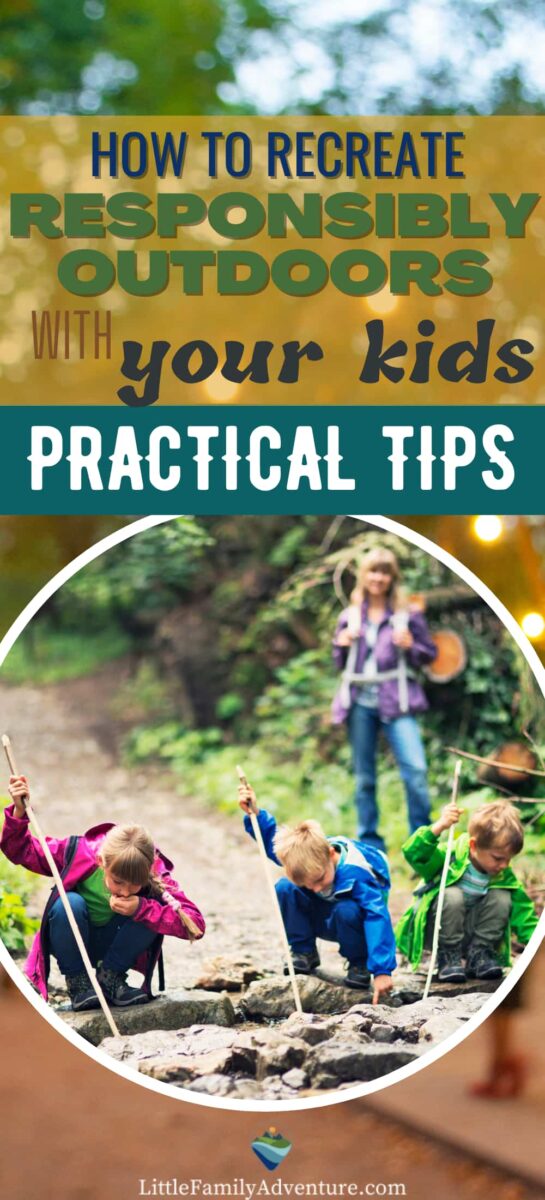Unlock the key to creating unforgettable outdoor experiences with your children while keeping them safe and responsible. Learn how to explore the great outdoors like a pro!
Planning a family outdoor adventure should be something to look forward to – and yet if you’re brimming over with concerns regarding the safety of venturing into the natural world as a unit, then it’s normal to also feel a bit bogged down by this process.
This article contains affiliate links. We earn from qualifying purchases.
Ultimately you want your little ones to grow up with a sense of wonder for the natural, so proper trip prep is part of this. The good news is that you don’t have to sacrifice safety in favor of adventure – it’s just a case of considering all the angles and getting ready for worst-case scenarios, while still having high hopes of making amazing memories together.
With all that said, here’s an overview of what it takes to go walkabouts with youngsters in tow while still protecting them from problems.

Instilling Environmental Respect in Kids
Introducing children to the outdoors is an opportunity to cultivate in them a respect for nature that will stay with them for their entire lives. This is particularly important to tackle head-on given that a typical child in the US now only spends around 7 minutes daily involved in outdoor play activities.
Turning this trend around begins with family adventures that are not only exhilarating but also educational, so take the following points into account when putting together a trip itinerary:
- Lead by Example: Kids mimic what they see. Show them how to minimize their footprint – stick to trails, pack out trash, and observe wildlife from a respectful distance. Also be sure to use eco-friendly products while traveling, building the entire experience around exemplifying green living.
- Engage Their Curiosity: Encourage questions about plants, animals, and ecosystems. Use technology responsibly – download identification apps like PlantNet, Seek and LeafSnap that educate on local flora and fauna.
- Incorporate Conservation Efforts: Join conservation programs or initiatives that allow your family to take part in habitat preservation during your escapades.
- Set Clear Guidelines: Before heading out, establish rules for behavior around wildlife and delicate areas. Explain why these guidelines matter, rather than just ruling with an iron fist without engaging kids with clear communication to back up the rules you lay down.
Making Safety-Focused Pre-Adventure Preparations
Preparation is the invisible safety net on every family outing, and since 85% of people plan to vacation with their kids, according to an NYU study, you need to put in the hard yards to sidestep the potential hazards that might crop up when you’re away from home comforts. Here’s how to ensure your family is property equipped:
- Review the Weather Forecast: Check forecasts regularly before departure. Endow each family member with gear suitable for the worst expected conditions – whether that’s clothing and sunblock for harsh rays, or warm jackets for wintry winds.
- Know Before You Go: Familiarize yourself with the terrain using maps and guides. Highlight potential hazards and discuss them with your kids – so for instance if you’re going to be heading into woods where bears and other dangerous wildlife might roam, get everyone on the same page regarding how to handle this scenario.
- Pack Smart: Create checklists for essential items – water, snacks, first-aid kit, navigation tools, and sun protection – and involve your children in the packing process. This will help to form good habits, and also means that you don’t have to tell them where everything is when they need to get access to it.
- Emergency Protocols: Teach basic emergency responses appropriate for children’s ages and ensure everyone knows what to do if separated.
It’s also necessary to incorporate an appreciation for what steps you’ll need to take as a parent if something serious goes wrong during your travels. So for instance, if you are involved in an auto collision, it’s useful to know how to tell who is at fault in a car accident – as this will ensure you can remain level-headed and steer clear of common mistakes in this situation. Things can go wrong on public highways just as much as in the wilderness, so do your due diligence and keep your family out of harm’s way.

Balancing Exploration with Limitations via Boundary Setting
Even the most unfettered exploration requires boundaries, especially when safety is a priority. You don’t want to be one of the 10,000+ people rescued in major operations in the US alone over the past four decades. Establishing clear limits is essential to prevent becoming part of this statistic, and this can involve:
- Clearly Marked Parameters: Before any excursion, define the physical boundaries of where children can explore. Use landmarks and maps to illustrate these limits – whether that’s the edge of the clearing where you’re camping, or the boundaries of the tent itself after darkness falls. Even if you’re in an RV, there are rules to follow and etiquette to adhere to, so don’t take creature comforts as a signal to let standards slip.
- Buddy System Reinforcement: Pair up family members and stress the importance of staying together, especially in unfamiliar or challenging environments.
- Time Checks: Set regular intervals for check-ins or breaks which can serve as times to regroup and assess everyone’s condition and location.
- Teach Respectful Exploration: Instill a sense of responsibility for not venturing beyond what is personally safe or environmentally sound. It can’t all be finger-wagging and rule-setting, otherwise kids will come to associate the great outdoors with draconian enforcement of limits, rather than the freedom it should really represent.
Key Takeaways
The main point is that memories made during outdoor adventures should not come at the expense of either safety or the environment, and moreover that by building this into your planning, you can raise children who are just as infatuated with the wild side of the planet as you are.
Throughout this process, it’s a good idea to bring the kids onboard with everything you’re doing to get ready. This not only doubles down on the lessons you’re hoping to impart and the safety-focused rules being established, but also gives them a stake in the trip from the start. If they’re active participants in this way, rather than merely passengers, it’ll be all the more unifying and enjoyable for the whole family unit.
For more family activity inspiration, check out our latest posts here:
- 40 Best Experience Gifts for Families This Christmas

- How to Wrap Experience Gifts: 15 Creative Ideas to Make Memories Unwrappable

- 19 Essential Gifts for New Puppy Owners That Any Dog Would LOVE

- 20+ Best Food Subscription Boxes to Save You Time & Money

- 23 Must-Have Clothing Essentials to Pack for Winter Travel

- BEST (no-sew) Camping Indoor Playhouse for Kids





Thanks for sharing
This article is spot-on! I remember taking my kids on a nature walk and they were so curious about everything. We followed the tips, stuck to the trails, and even used a plant ID app. It was a great way to teach them respect for nature. How do you plan to make your next outdoor adventure extra educational?